Fri, Aug 23, 2013
Redesign For Sudden Autopilot Disconnection Needed, Say Flight Safety Experts
Flight safety experts associated with the Human Factors and Ergonomics Society studying recent high-profile aviation accidents found sudden autopilot disconnection to be a design flaw that creates unnecessary emergencies by surprising pilots during critical, high-workload episodes.

“The sudden disengagement of autopilot is analogous to a pilot suddenly throwing up his or her hands and blurting to the copilot, ‘Your Plane!’” said Eric E. Geiselman, lead author of a recently published two-article Ergonomics in Design series, “Flight Deck Automation: Invaluable Collaborator or Insidious Enabler” (July issue) and “A Call for Context-Aware Logic to Improve Safety”.
Eric E. Geiselman, along with co-authors Christopher M. Johnson, David R. Buck, and Timothy Patrick, have combined expertise as pilots, crew resource management instructors, and human factors researchers. They studied the 2009 Colgan Air crash in Buffalo, New York, and the 2009 Air France crash off the coast of Brazil with a focus on how humans and machines can best communicate on the flight deck.
The authors recommend that autopilot systems transfer controls following the same protocols crew members use – with acknowledgement by the receiving pilot that he or she has assumed control. FAA regulations require a visual and auditory warning to occur following autopilot shutoff, but Geiselman and his co-authors emphasize that such warning should occur before – not after - autopilot is disengaged.
The authors report on many other design-level safety issues in these articles and offer prototypes featuring solutions that can be affordably implemented with available technology. They believe better design of automation technology on planes can prevent future accidents and that more pilot training shouldn’t be the only solution pursued by the industry.
The Human Factors and Ergonomics Society is a nonprofit individual-member, multidisciplinary scientific association for human factors/ergonomics professionals, with more than 4,600 members globally.
More News
Light Gun A handheld directional light signaling device which emits a brilliant narrow beam of white, green, or red light as selected by the tower controller. The color and type of>[...]
"The journey to this achievement started nearly a decade ago when a freshly commissioned Gentry, driven by a fascination with new technologies and a desire to contribute significan>[...]
Aero Linx: JAARS, Inc. For decades now, we’ve landed planes on narrow rivers and towering mountains. We’ve outfitted boats and vehicles to reach villages that rarely se>[...]
"Our driven and innovative team of military and civilian Airmen delivers combat power daily, ensuring our nation is ready today and tomorrow." Source: General Duke Richardson, AFMC>[...]
Aircraft Conflict Predicted conflict, within EDST of two aircraft, or between aircraft and airspace. A Red alert is used for conflicts when the predicted minimum separation is 5 na>[...]
 ANN's Daily Aero-Term (04.20.24): Light Gun
ANN's Daily Aero-Term (04.20.24): Light Gun Aero-News: Quote of the Day (04.20.24)
Aero-News: Quote of the Day (04.20.24) ANN's Daily Aero-Linx (04.21.24)
ANN's Daily Aero-Linx (04.21.24) Aero-News: Quote of the Day (04.21.24)
Aero-News: Quote of the Day (04.21.24) ANN's Daily Aero-Term (04.21.24): Aircraft Conflict
ANN's Daily Aero-Term (04.21.24): Aircraft Conflict



